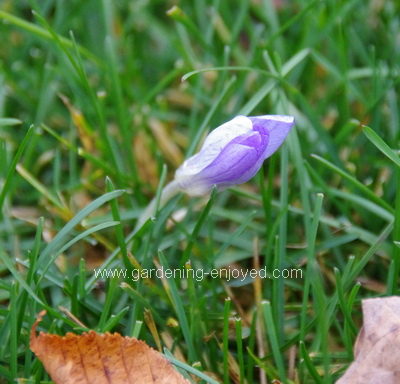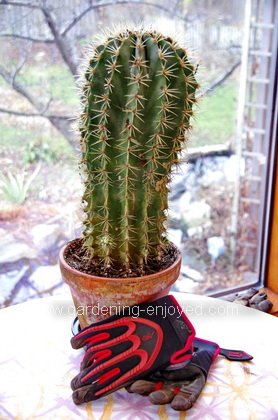
I found this tiny marvel late last week when I was wandering in the back of the garden. I sat down to write Dallying on Saturday morning and then the grandchildren arrived because our local Santa Clause parade happens to go right past our door. Their parents then suggested that the three grandchildren stay with us for the afternoon while they went shopping. They even had a gingerbread house kit ready to keep them occupied. Any thought of telling my readers about this tiny Autumn Crocus quickly disappeared into a mess of icing sugar and coloured candies. That Crocus is amazing for a couple of reasons. I didn’t plant it there but that’s not surprising, they move around readily. That area was filled with weeds and I had cleaned it out and rototilled it and then laid down the lovely sod that you can see. Did all that mid September and then on the last day of November this little Crocus flower pushes its way up through that new sod and provides me with a delightful
surprise. Some days Mother Nature just tries extra hard to make up for some of the less pleasant things she provides me with. This morning it snowed and I’ve officially declared the outdoor gardening season over. That doesn’t mean it was completed, it’s just over. Spring will reveal many things.
 Hopefully I can now get back to a more regular schedule for “Dallying.” It has been somewhat erratic this fall for a variety of reasons. Some things are just easy to put off until tomorrow. This Cactus is another. It desperately needed a bigger pot but it is as unfriendly as it looks. Those are very hard and very sharp spines on it and they don’t entice you to cuddle it or even to repot it. The Assistant Gardener was wondering just how much longer it was going to live on the breakfast table so I dug out the heavy leather gloves and attacked. First step is to take some of the usual peat based soilless mix and amend it with some coarse grit to make it much more readily drainable. Cactus don’t usually fnd themselves growing in a peat bog. The Cactus is then tipped gently onto its side and the pot is removed. The larger pot is partially filled with the amended soil and now we have no choice but to
pick up that prickly monster and insert it into the pot. A great test of the chosen gloves. I packed enough new soil, to hold the plant upright, around it using a wooden stick to avoid shoving my fingers into the soil close to those thorns. Then carry it back to its winter home and water it. It is really amazing how heavy it is. Maybe all the tender loving care will convince it to reward me with some blooms this winter. Cactus blooms are usually quite magnificent.
Hopefully I can now get back to a more regular schedule for “Dallying.” It has been somewhat erratic this fall for a variety of reasons. Some things are just easy to put off until tomorrow. This Cactus is another. It desperately needed a bigger pot but it is as unfriendly as it looks. Those are very hard and very sharp spines on it and they don’t entice you to cuddle it or even to repot it. The Assistant Gardener was wondering just how much longer it was going to live on the breakfast table so I dug out the heavy leather gloves and attacked. First step is to take some of the usual peat based soilless mix and amend it with some coarse grit to make it much more readily drainable. Cactus don’t usually fnd themselves growing in a peat bog. The Cactus is then tipped gently onto its side and the pot is removed. The larger pot is partially filled with the amended soil and now we have no choice but to
pick up that prickly monster and insert it into the pot. A great test of the chosen gloves. I packed enough new soil, to hold the plant upright, around it using a wooden stick to avoid shoving my fingers into the soil close to those thorns. Then carry it back to its winter home and water it. It is really amazing how heavy it is. Maybe all the tender loving care will convince it to reward me with some blooms this winter. Cactus blooms are usually quite magnificent.
 Here is a Cactus that proves that point. This is Schlumbergera truncata the Thanksgiving Cactus, that blooms reliably on American thanksgiving and we Canadians think it’s about a month late as we celebrate Thanksgiving in the middle of October. Nonetheless it is a great houseplant that requires very little care and provides this brilliant display that will continue for several weeks. In its native habitat it is an epiphyte, it grows in the tropics attached to tree branches and gets it water and nutrients from the air around its roots. It can easily be over watered when growing in soil but it also must never be allowed to dry out. It requires a loose well drained soil so that its roots also get sufficient air and they are not surrounded by constantly wet conditions. Mine spends the summer outside in fairly heavy shade and then moves into the solarium for the winter. That’s the secret to
its success. There is rarely any artificial light on in the solarium so this Cactus experiences the short days that it needs to initiate its blooms.
Here is a Cactus that proves that point. This is Schlumbergera truncata the Thanksgiving Cactus, that blooms reliably on American thanksgiving and we Canadians think it’s about a month late as we celebrate Thanksgiving in the middle of October. Nonetheless it is a great houseplant that requires very little care and provides this brilliant display that will continue for several weeks. In its native habitat it is an epiphyte, it grows in the tropics attached to tree branches and gets it water and nutrients from the air around its roots. It can easily be over watered when growing in soil but it also must never be allowed to dry out. It requires a loose well drained soil so that its roots also get sufficient air and they are not surrounded by constantly wet conditions. Mine spends the summer outside in fairly heavy shade and then moves into the solarium for the winter. That’s the secret to
its success. There is rarely any artificial light on in the solarium so this Cactus experiences the short days that it needs to initiate its blooms.
Now it’s time to answer a few of my reader’s questions. Don’t forget to check the front page of the Website for frequent short ideas for current gardening activities.
Alexandre Asks? Great advice on hibiscus....since I am currently fighting a whitefly invasion. I've decided to give my hibiscus a little chill outside since it's below zero...just a few hours. So far less whitefly and my hibiscus don't seem affected so far. I've been using the sticky yellow cardboard with good results when shaking leaves. Is there another homemade solution that really work's against whitefly?
Ken Answers!
Whitefly are a nasty problem. They are easily killed with an insecticidal soap spray, the hard part is hitting them with it. It
must contact the adult to be effective. Since they have about a 4 day life cycle you need to spray every second or third day to catch the newly hatched before they lay the next batch of eggs. As you have noticed those adults tend to fly away as you approach. They don't at night. That finds you spraying the underside of the leaves, that's where they live, in the dark. Not an easy proposition. The yellow sticky boards are a lot easier, even if not totally effective.
Catherine Asks? Great tips about how to treat a hibiscus in the fall. How do you develop a hibiscus standard? Ours has four main shoots and straggly stems. Can it be pruned into a standard? Thanks for your newsletter.
Ken Answers! I confess, mine was a standard when I acquired it. Choose the most vertical of the four stems and remove the others, physically easy, emotionally difficult. If the four stems are supple and close together you could braid all or some of them into a
single stem. Each year just keep removing the lower branches and train a single stem upwards. Slow but it will eventually get what you want.
|

 Hopefully I can now get back to a more regular schedule for “Dallying.” It has been somewhat erratic this fall for a variety of reasons. Some things are just easy to put off until tomorrow. This Cactus is another. It desperately needed a bigger pot but it is as unfriendly as it looks. Those are very hard and very sharp spines on it and they don’t entice you to cuddle it or even to repot it. The Assistant Gardener was wondering just how much longer it was going to live on the breakfast table so I dug out the heavy leather gloves and attacked. First step is to take some of the usual peat based soilless mix and amend it with some coarse grit to make it much more readily drainable. Cactus don’t usually fnd themselves growing in a peat bog. The Cactus is then tipped gently onto its side and the pot is removed. The larger pot is partially filled with the amended soil and now we have no choice but to
pick up that prickly monster and insert it into the pot. A great test of the chosen gloves. I packed enough new soil, to hold the plant upright, around it using a wooden stick to avoid shoving my fingers into the soil close to those thorns. Then carry it back to its winter home and water it. It is really amazing how heavy it is. Maybe all the tender loving care will convince it to reward me with some blooms this winter. Cactus blooms are usually quite magnificent.
Hopefully I can now get back to a more regular schedule for “Dallying.” It has been somewhat erratic this fall for a variety of reasons. Some things are just easy to put off until tomorrow. This Cactus is another. It desperately needed a bigger pot but it is as unfriendly as it looks. Those are very hard and very sharp spines on it and they don’t entice you to cuddle it or even to repot it. The Assistant Gardener was wondering just how much longer it was going to live on the breakfast table so I dug out the heavy leather gloves and attacked. First step is to take some of the usual peat based soilless mix and amend it with some coarse grit to make it much more readily drainable. Cactus don’t usually fnd themselves growing in a peat bog. The Cactus is then tipped gently onto its side and the pot is removed. The larger pot is partially filled with the amended soil and now we have no choice but to
pick up that prickly monster and insert it into the pot. A great test of the chosen gloves. I packed enough new soil, to hold the plant upright, around it using a wooden stick to avoid shoving my fingers into the soil close to those thorns. Then carry it back to its winter home and water it. It is really amazing how heavy it is. Maybe all the tender loving care will convince it to reward me with some blooms this winter. Cactus blooms are usually quite magnificent. Here is a Cactus that proves that point. This is Schlumbergera truncata the Thanksgiving Cactus, that blooms reliably on American thanksgiving and we Canadians think it’s about a month late as we celebrate Thanksgiving in the middle of October. Nonetheless it is a great houseplant that requires very little care and provides this brilliant display that will continue for several weeks. In its native habitat it is an epiphyte, it grows in the tropics attached to tree branches and gets it water and nutrients from the air around its roots. It can easily be over watered when growing in soil but it also must never be allowed to dry out. It requires a loose well drained soil so that its roots also get sufficient air and they are not surrounded by constantly wet conditions. Mine spends the summer outside in fairly heavy shade and then moves into the solarium for the winter. That’s the secret to
its success. There is rarely any artificial light on in the solarium so this Cactus experiences the short days that it needs to initiate its blooms.
Here is a Cactus that proves that point. This is Schlumbergera truncata the Thanksgiving Cactus, that blooms reliably on American thanksgiving and we Canadians think it’s about a month late as we celebrate Thanksgiving in the middle of October. Nonetheless it is a great houseplant that requires very little care and provides this brilliant display that will continue for several weeks. In its native habitat it is an epiphyte, it grows in the tropics attached to tree branches and gets it water and nutrients from the air around its roots. It can easily be over watered when growing in soil but it also must never be allowed to dry out. It requires a loose well drained soil so that its roots also get sufficient air and they are not surrounded by constantly wet conditions. Mine spends the summer outside in fairly heavy shade and then moves into the solarium for the winter. That’s the secret to
its success. There is rarely any artificial light on in the solarium so this Cactus experiences the short days that it needs to initiate its blooms.